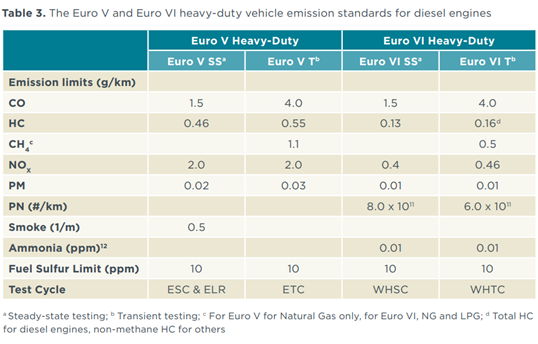THE EURO VI STANDARDS FOR HEAVY-DUTY VEHICLES

The Euro V and Euro VI heavy-duty vehicle emission standards for diesel engines
The Euro VI standards were originally set out in Regulation 595/2009 and its implementing Regulation 582/2011, with further amendments contained in Regulation 133/2014. The Euro VI emission limits went into effect in 2013 for new type approvals and in 2014 for all registrations.
EMISSION LIMIT VALUES
Table 3, below, shows the emission limits for the Euro V and Euro VI standards. As with light-duty vehicles, the move from Euro V to Euro VI saw a large reduction in the NOX emission limit, from 2.0 g/kWh to 0.4 g/kWh in steady-state testing, and from 2.0 g/kWh to 0.46 g/kWh in transient testing, or reductions of 80% and 77% respectively. The particle mass limit was also significantly tightened, cut in half from 0.02 g/kWh to 0.1 g/kWh on steady-state testing, and from 0.03 g/kWh to 0.01 g/kWh on transient testing, a reduction of 66%. The Euro VI standards include for the first time a particle number limit. The limit is 8 x 1011 particles per kilowatt-hour under the WHSC test, and 6 x 1011 under the WHTC test. The vehicle certification test cycle to meet the Euro VI standards is different from that used for Euro V, so the comparisons are only approximate. The test cycles are discussed further in the “testing” section below. The Euro VI standards also set emission limits for ammonia since the tighter NOX standard will require the use of Selective Catalytic Reduction aftertreatment, which in turn relies on the injection of urea into the exhaust stream. The catalytic reaction can produce ammonia as an unwanted by-product, hence the limits on ammonia emissions for heavy-duty diesel vehicles (gasoline vehicles, also called “positive ignition” vehicles, are exempt from the ammonia limit since urea is not used for NOX control). The Euro VI standards include a methane emission limit for “positive-ignition” vehicles (i.e., not diesels, but specifically natural gas and liquefied petroleum gas engines) based on the emergence of natural gas-powered vehicles in the heavy-duty vehicle sector and the potential impacts of methane on tropospheric ozone.

The Euro V and Euro VI heavy-duty vehicle emission standards for diesel engines
TESTING
Regulatory test cycles for heavy-duty engines have continuously improved over the European regulatory pathway for these vehicle types. At Euro I and II levels, the tests were carried out over the R-49 cycle, which was a steady-state cycle sampling thirteen points on the engine map (which reflects all potential combinations of torque and engine speed). Under the Euro III standards established in 2000, the testing regime was somewhat complex. Heavy-duty engines were tested over three different cycles: the European Steady-State Cycle (ESC), the European Transient Cycle (ETC), and the European Load Response Cycle (ELR, which was instituted to measure smoke emissions). The ESC consists of a weighted sum of emissions over thirteen modes, or combinations of engine load and engine speed, run at steady state. The ETC cycle is based on realworld drives and made up of 3 sections representing, respectively, urban drives with many stops and starts and an average speed of ~50 kph, rural drives with an average speed of ~72 km/h, and motorway driving with an average speed of ~88 kph. For Euro III, ESC/ELR tests were used for conventional diesel engines, ESC/ELR plus ETC tests were used for diesel engines with advanced aftertreatment (NOX aftertreatment or diesel particulate filters or DPFs), and finally an ETC test was used for positive-ignition engines using natural gas or LPG. For Euro IV and V, diesel engines were tested using the ESC/ELR test and positive-ignition engines were tested on the ETC. In the Euro VI standards, these tests were replaced by the World Harmonized Stationary Cycle (WHSC) and the World Harmonized Transient Cycle (WHTC). These new cycles were agreed upon within the United Nations Economic Commission for Europe, with the European emission limit values being established under both the World Harmonized Stationary Cycle (WHSC) and the World Harmonized Transient Cycle (WHTC). For certification of heavy-duty vehicle emissions, engines are tested on a test bed and emissions are reported as g/kWh. The WHSC is a steady-state cycle also based on a weighted sum of emissions over thirteen modes, which are combinations of engine speed and load. The cycle is based on real-world drives in Europe, the United States, Japan, and Australia. It is a hot-start cycle following preconditioning at an engine speed of 55% and 50% load. The WHTC test is a transient engine test of 1800 seconds, with several motoring segments, originally developed by the UNECE Working Party on Pollution and Energy. It is based on the worldwide pattern of real-world heavy commercial vehicle use based on typical driving conditions found in Europe, the United States, Japan, and Australia.
